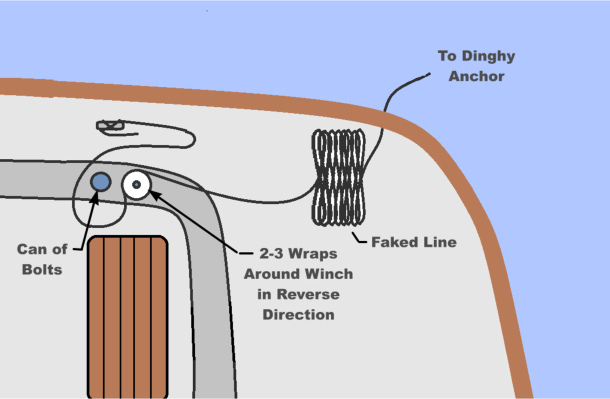The Blue View - Anchor Alarms
/We routinely use an anchor alarm when we are on the hook. This is an alarm that goes off if we drift too far from our current position, warning us that we are either dragging our anchor or that the wind has shifted significantly. It is an especially good thing to have when we are anchored in an anchorage with less than optimal holding, in a small anchorage that has rocks or other hazards within swinging range of our anchor, or if there is bad weather in the forecast. It's also a good thing to have when the holding is good, the anchorage has plenty of swinging room and the forecast is benign – because you just never know.
When we first started cruising, GPS's were more expensive, less accurate and real power hogs, and didn't make the best anchor alarms. We learned from an old salt how to make a manual anchor alarm that usually worked pretty well. We would start with a small dinghy anchor and about 200 feet (60m) or so of small, non-floating line attached. Once we were anchored and settled in, we would drop the dinghy anchor over the stern and attach the bitter end to a cleat. Then we would wrap the line 2-3 times around a winch in the reverse direction, leaving about 6' (2m) of slack between the bitter end and the winch, and fake the remaining line on the aft deck. By wrapping it in the reverse direction, when the line is pulled in the direction of the anchor, the winch turns, making the clicking noise. If the main anchor dragged or if the wind shifted and the boat drifted more than the length of the line, the dinghy anchor would stay put until all the slack was played out, then the winch would turn until the extra line between the winch and the cleat was taut. The clicking noise of the winch wasn't enough to wake us from a sound sleep, especially if the wind was howling, but if we took something that would make a lot of noise if it got knocked over, like a can of bolts, and rigged the slack in the line so that it would knock the can over when it went taut, we were sure to wake up if we were dragging. We had a lot of false alarms, but it always let us know if we were dragging or if the wind shifted and we were in danger of running aground.
Now, of course, we have several GPS's aboard that have automatic anchor alarm features built in, and the accuracy has gone from a few hundred feet to something like 6 feet, so we no longer need to use the manual system. We have a couple of anchor alarm apps for our tablet as well. They are quite sophisticated, with lots of bells and whistles, and are quite fun to set up and play with. I'm not quite ready to trust them yet, however. Our iPad often loses its GPS fix below deck. Sometimes, it gets preoccupied and forgets to update its position. Sometimes it gets a bad fix and suddenly thinks we are somewhere else for a for a short period. Also, since it uses considerably more power when using the GPS feature and it must be left on continuously, it needs to be plugged in. I really like our tablet, but I still think of it as a backup system and am a bit wary of depending on it entirely.
Instead, we keep one of our handheld GPS's plugged in by our berth and set the alarm every night we are at anchor. If the anchorage is large with no hazards to worry about and the holding is good, we set the allowable distance quite large. If there is limited swinging room or there are any hazards downwind, we set the leash quite small. This makes for more false alarms, but false alarms are a reasonable trade-off for increased reaction time if there should be a problem. By having the GPS at the bedside, not only are we assured of hearing the alarm, but a quick glance at the display will quickly tell us if we have an actual problem or whether the alarm is due to a small benign wind shift.
We set the GPS to display our position graphically, then zoom in so that the page resolution is 200 feet (60m) or so and turn the tracking on. After a few hours, the display should show a nice arc as the boat swings at anchor. The graphic display will clearly show a large wind shift or if we are dragging. Each morning, if we are staying another day, we clear the tracking history, which clears the old track and starts a new one.
We have used the anchor alarm every night since leaving Adelaide. The combination of a new, unknown anchor, anchorages known for their bad holding, no shortage of hazards, and strong winds have made us especially diligent. We had several false alarms due to small wind changes, but during our first night in Kingscote harbor at Kangaroo Island, the alarm clearly showed we were dragging our anchor. We hustled on deck, but by the time we got there, the anchor had caught again and stopped dragging. We reset the alarm and kept an anchor watch for an hour or so. When we didn't drag again, we went back to bed knowing our anchor alarm was watching out for us.








